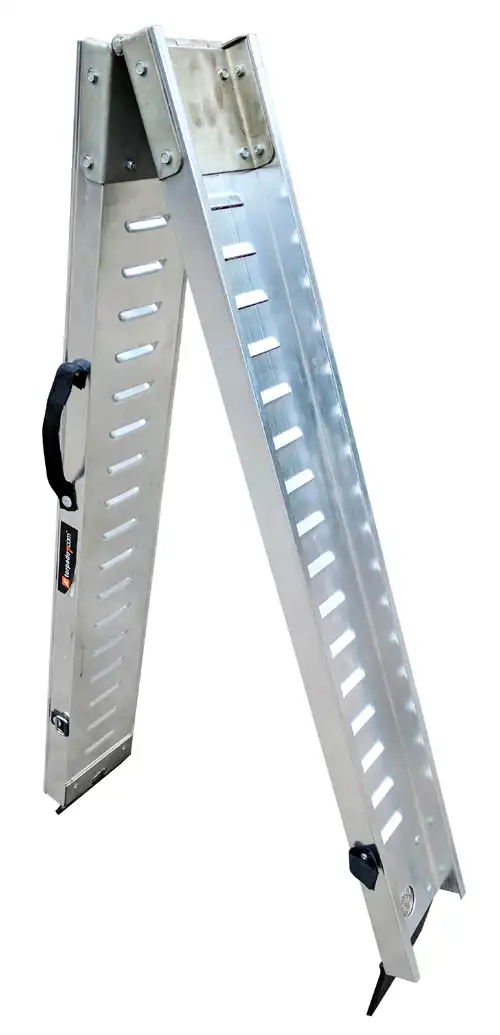Structural Integrity: The Foundation of Heavy-Duty Moto Ramps
Material Composition: Aluminum vs. Steel
The backbone of any reliable motorcycle ramp lies in its material composition. Aluminum ramps boast a lightweight yet sturdy structure, making them ideal for portable solutions. Their corrosion-resistant properties ensure longevity, even when exposed to harsh weather conditions. On the flip side, steel ramps offer unparalleled strength, capable of supporting the heaviest motorcycles without flexing. While heavier, steel ramps provide a sense of solidity that some riders prefer when loading valuable custom choppers or fully-loaded touring bikes.
Load Capacity: Matching Ramp Strength to Motorcycle Weight
A critical factor in selecting a heavy-duty motorcycle loading ramp is its load capacity. Manufacturers typically specify weight limits ranging from 750 to 1500 pounds for single ramps. For heavier applications, dual ramp systems can double this capacity. It's essential to consider not just the bike's dry weight but also any additional gear or modifications that could increase the overall load. A safety margin of at least 20% above your motorcycle's fully loaded weight is advisable to account for dynamic forces during loading.
Reinforcement Techniques: Enhancing Ramp Durability
Advanced ramp designs incorporate various reinforcement techniques to boost durability without adding excessive weight. Cross-bracing, often seen in arched ramps, distributes load evenly across the structure. Some manufacturers employ honeycomb patterns or ribbed surfaces to increase strength while maintaining a sleek profile. Edge reinforcements prevent warping and ensure the ramp maintains its shape even after repeated use. These enhancements contribute to a longer lifespan and consistent performance, crucial for heavy-duty applications.
Ergonomics and Usability: Maximizing Safety and Convenience
Ramp Length: Finding the Perfect Balance
The length of a motorcycle ramp significantly impacts its usability and safety. Longer ramps provide a gentler incline, reducing the risk of bottoming out low-clearance bikes or losing traction on wet surfaces. However, they can be unwieldy to transport and store. Shorter ramps offer easier handling but require more skill to navigate steeper angles. Some innovative designs feature extendable sections, allowing users to adjust the length based on their specific loading situation. This versatility is particularly valuable for those who transport various motorcycle types or load onto different vehicle heights.
Surface Traction: Ensuring Grip in All Conditions
A secure grip between the motorcycle's tires and the ramp surface is paramount for safe loading. Heavy-duty ramps often feature serrated or punch plate surfaces that provide excellent traction, even in wet conditions. Some manufacturers apply anti-slip coatings or integrate rubberized strips for additional grip. The ideal surface should strike a balance between providing sufficient traction and allowing smooth tire rotation to prevent sudden jerks or stops during the loading process. For maximum versatility, look for ramps with reversible surfaces – one side optimized for rubber tires and the other for studded tires or tracked vehicles.
Foldability and Storage: Compact Solutions for Space-Conscious Users
Despite their robust nature, many heavy-duty motorcycle ramps are designed with portability in mind. Folding mechanisms allow these substantial ramps to collapse into more manageable sizes for storage and transport. Some models feature multi-fold designs that can reduce the ramp to a third of its extended length. Quick-release pins or locking hinges ensure the ramp remains secure in both its folded and extended states. For those with limited storage space, look for ramps with integrated carrying handles or straps, making it easier to move and stow these essential tools between uses.
Specialized Features for Heavy-Duty Applications
Multi-Piece Ramp Systems: Customizable Loading Solutions
For the ultimate in flexibility, multi-piece ramp systems offer unparalleled adaptability to various loading scenarios. These systems typically consist of two or more separate ramps that can be used individually or combined for wider platforms. This modularity allows users to create custom loading configurations for different motorcycle types or even accommodate side-by-side ATVs. Some advanced systems include center sections that bridge the gap between ramps, providing a solid platform for walking alongside the vehicle during loading. The ability to adjust width and configuration makes multi-piece systems ideal for professional transporters or enthusiasts with diverse vehicle collections.
Integrated Safety Features: Enhancing Loading Security
Heavy-duty motorcycle ramps often incorporate advanced safety features to mitigate risks associated with loading heavy machines. Adjustable support struts provide additional stability, preventing the ramp from shifting during use. Some models feature built-in wheel chocks at the top of the ramp, securing the front wheel once the motorcycle reaches the loading surface. Raised side rails offer guidance and prevent accidental roll-offs, especially useful when loading in low-light conditions. For electrical safety, some high-end ramps include grounding straps to dissipate static electricity, reducing the risk of sparks when loading fuel-laden motorcycles.
Compatibility with Loading Aids: Leveraging Additional Tools
The most versatile heavy-duty motorcycle ramps are designed to work seamlessly with various loading aids. Attachment points for winches or come-alongs allow for assisted loading of particularly heavy or inoperable motorcycles. Some ramps feature integrated roller systems at the top, facilitating smooth transitions onto truck beds or trailers. Compatibility with loading jacks or dollies can significantly reduce the physical effort required to maneuver large motorcycles into position. When selecting a ramp, consider how it might integrate with your existing tools or future accessories to create a comprehensive loading system tailored to your specific needs.
Conclusion
Selecting the right motorcycle loading ramp for heavy-duty applications requires careful consideration of structural integrity, ergonomics, and specialized features. By evaluating factors such as material composition, load capacity, length, and traction, users can find a ramp that ensures safe and efficient motorcycle transportation. The integration of advanced safety features and compatibility with loading aids further enhances the functionality of these essential tools. Ultimately, investing in a high-quality, heavy-duty moto ramp not only protects valuable motorcycles but also provides peace of mind for riders and transporters alike.
Contact Us
For more information about our range of heavy-duty motorcycle ramps and loading solutions, please contact us at info@runva.com.cn. Our team of experts is ready to help you find the perfect ramp for your specific needs, ensuring your precious cargo is always transported safely and securely.

_1737625693698.webp)


